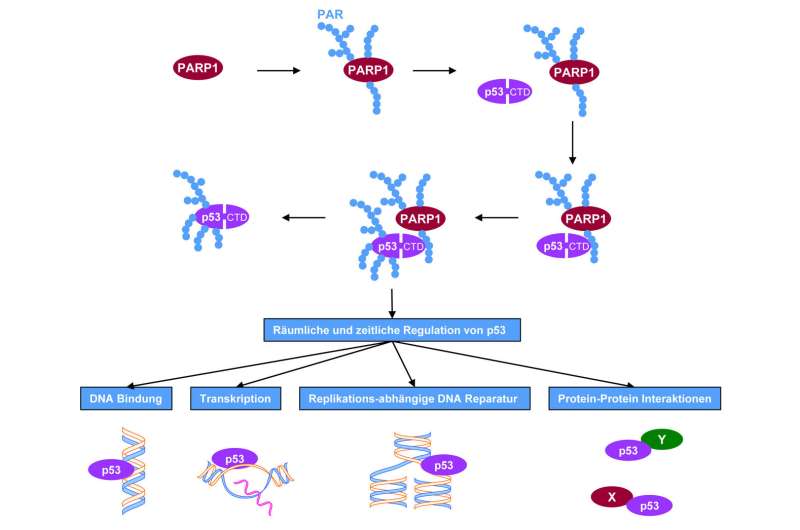When the 'guardian' and the 'caretaker' of the genome join forces

Biologists and chemists at the University of Konstanz have deciphered a molecular cellular mechanism related to the development of cancer. They report the interaction between the tumour-suppressor protein p53, known as the "guardian of the genome," and the enzyme PARP-1, the "caretaker of the genome." The collaboration with the University of Ulm and the Karlsruhe Institute of Technology (KIT) resulted in an article published in Nucleic Acids Research.
Internal and external influences such as metabolic processes, inflammatory reactions, environmental toxins and radiation cause random damage to the DNA of every cell of the human body. If the cell cannot repair these DNA damages in time, mutations and the development of cancer might be the result. Normally, if a cell is at risk of turning into a cancer cell, the protein p53 is activated. It triggers several molecular processes that halt cell division, known as cell cycle arrest. "Through cell cycle arrest, the cell gains time to repair dangerous DNA damage or, if there is an overwhelming load of damage, triggers programmed cell death," says toxicologist and biochemist Dr. Aswin Mangerich, who heads the project at Professor Alexander Bürkle's Chair of Molecular Toxicology at the University of Konstanz. "In this way, p53 counteracts the development of cancer and is therefore also known as the 'guardian of the genome,'" says Mangerich.
The protein p53 is highly relevant for biomedicine. In one-half of all human tumour types, the p53 gene is mutated such that its cancer-combating function is suppressed. These mutations give the cancer cells a survival advantage, since the important defence mechanisms of DNA repair and programmed cell death are turned off.
The scientists from Konstanz have now deciphered the molecular mechanism how the biochemical and cellular functions of p53 in interaction with the enzyme PARP-1 are controlled. "PARP-1 helps to coordinate DNA repair processes in the cell, and this is why it has been nicknamed the 'caretaker of the genome,'" says Aswin Mangerich. Dr. Arthur Fischbach, who is the lead author of the paper and worked on the project during his doctoral thesis, adds, "The enzyme PARP-1 detects DNA damage, is activated and forms the biopolymer poly(ADP-ribose) as one of the first reactions of the cell. In our paper we report the discovery that p53 first has to engage in a non-covalent (loose) binding to existing biopolymer. Only then, in a second step, can a covalently attached biopolymer be produced right on the p53 protein. This modification of p53 has far-reaching implications for the regulation of biochemical and cellular functions of p53."
More information: Arthur Fischbach et al, The C-terminal domain of p53 orchestrates the interplay between non-covalent and covalent poly(ADP-ribosyl)ation of p53 by PARP1, Nucleic Acids Research (2017). DOI: 10.1093/nar/gkx1205
Journal information: Nucleic Acids Research
Provided by University of Konstanz




















